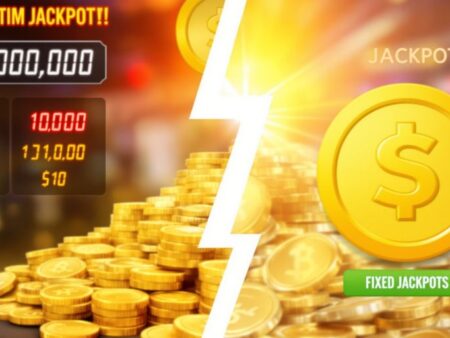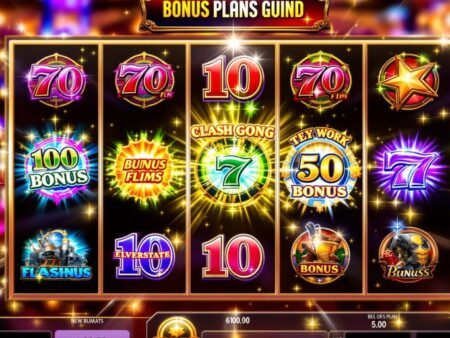Thinking about how to get more wins when you play slot machines? It’s not just about luck, you know. There’s a pretty important number called RTP, or Return to Player, that can really change how you play and maybe even how much you win. If you’re not sure what it means or how it works, don’t sweat it. We’re going to break down how return to player (RTP) affects slot machine strategy, so you can pick games that are better for you and have a better time playing.
Key Takeaways
- RTP shows the percentage of money a slot game pays back to players over a long time, not a guarantee for individual sessions.
- Higher RTP percentages generally mean better odds for players and a smaller advantage for the casino.
- While RTP is important, it’s not the only factor; consider game volatility, jackpot size, and personal preference.
- Understanding RTP helps in budgeting and choosing games that align with your risk tolerance and desired play style.
- Playing demo versions of games can help you understand their RTP and volatility before betting real money.
Understanding Return To Player (RTP)
Return to Player, or RTP, is a term you’ll hear a lot when talking about slot machines and other casino games. It’s basically a way to measure how much money a game is designed to pay back to players over a really long time. Think of it as a long-term average, not a guarantee for your next spin. It’s a pretty important number if you want to get a feel for the odds. Some games are more generous than others, and knowing the RTP helps you figure that out.
Defining RTP in Casino Games
RTP is the percentage of all the money wagered on a specific game that is paid back to players over an extended period. For example, a slot machine with a 96% RTP means that, on average, for every $100 wagered, the game will return $96 to players. The remaining 4% is the house edge, which is how the casino makes its profit. It’s a theoretical figure, mind you, calculated over millions, if not billions, of game rounds. So, it’s not about what happens in one session, or even ten. It’s a statistical average that reflects the game’s payout structure.
How RTP is Calculated Over Time
Calculating RTP isn’t something you can do after a few spins. It’s a complex mathematical process that involves analyzing the game’s payout tables and the probability of hitting winning combinations across countless simulated plays. Game developers program these percentages into the software. The longer and more frequently a game is played by a large number of people, the closer the actual results tend to get to the theoretical RTP. It’s a bit like flipping a coin; you might get heads five times in a row, but over thousands of flips, you’ll get very close to a 50/50 split. Slot machines work on a similar principle, just with much more complicated math involved.
The Meaning of RTP Percentages
So, what does that percentage actually mean for you, the player? A higher RTP percentage generally indicates a game that is more favorable to players in the long run. If you see two games, one with a 94% RTP and another with a 97% RTP, the 97% game is statistically more likely to give you a better return on your wagers over time. However, it’s vital to remember that RTP doesn’t dictate short-term results. You could play a 98% RTP game and lose money for an hour, or play a 92% RTP game and hit a big win. The percentage is a guide, not a crystal ball. It helps you make informed choices about which games might offer better value.
Theoretical Versus Actual RTP
So, you’ve heard about RTP, the Return to Player percentage, and how it’s supposed to tell you how much a slot machine pays back. But there’s a bit more to it than just a single number. We need to talk about the difference between what’s theoretical and what actually happens when you play.
What Theoretical RTP Represents
Think of theoretical RTP as a long-term average, like a prediction based on a massive number of spins. If a slot game boasts a 96% theoretical RTP, it means that, over millions and millions of plays, the game is designed to return 96 cents for every dollar wagered. It’s a mathematical average, calculated by the game developers. This number doesn’t care about your personal luck or how many times you’ve spun the reels today. It’s a statistical expectation, a promise of fairness over an immense scale of gameplay. It’s the blueprint, the intended payout rate before anyone even sits down to play.
Why Actual RTP Differs
Now, here’s where things get interesting, and maybe a little messy. Actual RTP is what you, as an individual player, experience during your gaming sessions. Because slot machines rely on Random Number Generators (RNGs), each spin is a completely independent event. This means short-term results can swing wildly. You might hit a few big wins in a row, or you might go through a long dry spell. Your actual RTP for a single session could be much higher or much lower than the theoretical RTP. It’s like flipping a coin; theoretically, you should get heads about 50% of the time, but in just ten flips, you might get seven heads or only three. That’s variance at play.
Short-Term vs. Long-Term Outcomes
This distinction is super important for how you approach slot strategy. Relying solely on theoretical RTP for immediate results is a mistake. A game with a 98% theoretical RTP doesn’t mean you’re guaranteed to win 98% of your money back in an hour. It’s more likely that you’ll see results closer to that 98% mark if you were to play for days, weeks, or even years, with thousands upon thousands of spins.
Here’s a simple way to look at it:
- Theoretical RTP: The average payout over an extremely large number of plays (think millions).
- Actual RTP: Your personal win/loss ratio during a specific gaming session or a limited number of plays.
So, while theoretical RTP is a good guide for choosing games that are generally more player-friendly over time, it’s not a crystal ball for your next spin. You might get lucky, or you might not. That’s the thrill, right?
How Return To Player (RTP) Affects Slot Machine Strategy
So, how does this whole Return to Player thing actually change how you play slots? It’s not just some number they put on the screen to look fancy. Thinking about RTP can really shape your choices and maybe even help your money last a bit longer. It’s like having a little secret weapon in your pocket, you know?
Choosing Games with Favorable RTP
Look, if you want your bankroll to stretch, picking games with a higher RTP is a smart move. We’re talking about games that give back more of the money bet over time. Most online slots hover around 95% RTP, but you can find some that go up to 98% or even 99%. That extra few percent might not sound like much, but over many spins, it really adds up. It means the house has a smaller edge, which is good for you. It’s not a guarantee you’ll win, but it’s a better starting point.
Improving Your Winning Chances
While RTP doesn’t promise you’ll win on every spin, it does give you a better idea of the game’s long-term payout. A game with a 97% RTP means, theoretically, for every $100 wagered, $97 is returned to players. This is a much better deal than a game with, say, an 88% RTP. So, when you’re browsing the game library, keep an eye out for those higher percentages. It’s a simple way to tilt the odds a little more in your favor. Don’t forget to check other things too, like how often the game pays out (volatility) and if the bonus features seem interesting. It’s a mix of things that makes a good slot choice.
The Impact of RTP on Budgeting
This is where RTP really helps with managing your money. If you’re on a tight budget, playing games with a higher RTP means your money is likely to last longer. You might not hit massive wins as often as in a low RTP game, but you’ll probably have more smaller wins along the way. This can make your playing session feel more rewarding and less like you’re just burning through cash. It’s about playing smarter, not just playing more. Think of it like this:
| RTP Percentage | Expected Return per $100 Bet |
|---|---|
| 99% | $99 |
| 97% | $97 |
| 95% | $95 |
| 92% | $92 |
See? That difference matters. It helps you set realistic expectations and plan your spending. You can decide if you want to chase those big, infrequent wins or have a more steady, longer play session. It’s all about what kind of experience you’re looking for.
High RTP Games Versus Low RTP Games
When you’re looking at slot machines, you’ll see different payout percentages, and this is where Return to Player (RTP) really comes into play. It’s not just a number; it’s a guide to how a game tends to pay out over a lot of plays. Think of it like this: a game with a higher RTP is generally going to give back more of the money wagered over the long haul. It’s a simple concept, but it can really change how you pick your games.
Characteristics of High RTP Slots
Games with high RTP, often sitting at 95% or even higher, mean the house has a smaller edge. This translates to more of your money staying in play longer. You might not hit massive jackpots every time, but the wins tend to be more frequent and less dramatic. It’s like getting a steady trickle of water instead of a sudden flood. This can be great for your budget, letting you enjoy the game for more spins. It’s a good choice if you like to play for a while and see some action without risking too much on any single spin.
Understanding Low RTP Slot Features
On the flip side, low RTP slots are the opposite. They might have RTPs below 94%, sometimes even lower. What does this mean for you? Well, the casino keeps a bigger slice of the pie. These games often come with higher variance, meaning the wins are less common, but when they do hit, they can be pretty substantial. It’s the high-risk, high-reward scenario. If you’re chasing that one big score and don’t mind long stretches without a win, a low RTP game might be your thing. Just be prepared for your bankroll to potentially drop faster.
Aligning Game Choice with Player Preference
So, which is better? It really depends on what you’re looking for. Are you someone who enjoys a longer, more relaxed gaming session with smaller, more frequent wins? Then a high RTP slot is probably your best bet. You get more playtime for your money, and the odds are slightly more in your favor over time.
Or are you the type who thrives on excitement, chasing those rare, big payouts, and doesn’t mind the risk? A low RTP slot might offer that thrill. It’s all about matching the game’s payout structure to your personal playing style and what you want to get out of your gaming session. There’s no single right answer; it’s about making a choice that fits you.
RTP and Slot Volatility: A Crucial Distinction
So, you’ve got this RTP thing figured out, right? It tells you, on average, how much money a slot machine is supposed to give back over a really, really long time. But here’s where it gets a bit tricky, and honestly, a little exciting. RTP isn’t the whole story. You also gotta think about something called volatility, or variance. It’s like the personality of the slot machine. Does it give out small treats all the time, or does it hold out for a big, rare prize?
Defining Slot Volatility
Volatility, or variance, is all about how often a slot machine pays out and how big those payouts tend to be. Think of it like this: some machines are super generous with little wins, popping up almost every other spin. Others? They might make you wait, but when they finally decide to pay, it’s usually a much bigger chunk of change. It’s a big deal because it totally changes how you play and how your bankroll behaves.
How Variance Influences Wins
Let’s break down what this means for your actual playtime. High volatility slots are the daredevils. They might have fewer winning spins, but those wins can be massive. You could go through a bunch of spins without much happening, then suddenly hit a huge jackpot. It’s a rollercoaster, for sure. On the flip side, low volatility slots are the steady Eddies. They pay out more often, but the wins are usually smaller. This means your money might last longer, and you get that satisfying feeling of winning more frequently, even if it’s just a few coins.
Here’s a quick look:
- High Volatility: Infrequent wins, larger payouts. Think big jackpots, but you might need patience.
- Low Volatility: Frequent wins, smaller payouts. Good for playing longer and getting more regular wins.
- Medium Volatility: A mix of both. Offers a balance between win frequency and payout size.
Balancing RTP with Volatility
Now, how do you put these two together? It’s not just about picking the highest RTP. You need to match it with the volatility that fits your style and your budget. If you’re playing with a smaller amount of money and want to have fun for a while, a low volatility slot with a decent RTP is probably your best bet. You’ll get more spins and smaller, more frequent wins. But if you’re feeling lucky, have a bigger budget, and are chasing that life-changing win, a high volatility slot with a good RTP might be more your speed. Just remember, high RTP doesn’t mean you’ll win big fast; it’s about the long haul. It’s a bit like choosing between a quick snack and saving up for a feast. Both have their place, but you gotta know what you’re aiming for. It’s all about making smart choices based on what you want from your gaming session.
Navigating Common Misconceptions About RTP
Lots of people think that if a slot machine says it has a high Return to Player (RTP) percentage, like 98%, that means they’re guaranteed to win back almost all their money every time they play. That’s just not how it works, and it’s a pretty big misunderstanding.
RTP Does Not Guarantee Immediate Wins
Think of RTP as a long-term average. It’s calculated over millions, maybe even billions, of spins. So, if a game has a 96% RTP, it means that over a huge number of plays, players as a group will get back 96% of all the money wagered. For you, playing for an hour or even a few sessions, your results could be wildly different. You might win big, or you might lose your entire stake. RTP doesn’t promise you’ll win a specific amount in any single session. It’s a statistical average, not a personal guarantee.
The Role of Randomness in RTP
Slot machines are built on random number generators (RNGs). These systems ensure that every spin is completely independent of the last one. The outcome of your spin is purely down to chance. So, even if you’ve had a string of bad luck, the next spin doesn’t owe you a win to balance things out. The RTP percentage is the expected outcome over a vast number of plays, not a rule that dictates short-term results. It’s like flipping a coin; if you get heads five times in a row, the chance of tails on the next flip is still 50/50. It doesn’t suddenly become more likely because of past results.
RTP is Based on Extensive Play
This is a really important point. The RTP figures you see are not based on a few people playing for a short time. They are statistical probabilities derived from an enormous amount of game data. Imagine a casino tracking every single spin on a particular machine for years. That’s the kind of scale needed to accurately determine RTP. So, while a 95% RTP sounds great, it’s a reflection of what happens over a massive sample size. Your personal experience is just a tiny snapshot of that much larger picture. It’s easy to get caught up in the excitement of a win or the frustration of a loss, but remember that RTP is a measure of the game’s overall behavior, not yours specifically.
The Industry Perspective on RTP
Casinos, both online and brick-and-mortar, definitely pay attention to RTP. They know players like games that give them a better shot at winning back their money. It’s a big draw, you know? Advertising games with higher RTP rates can bring more people through the virtual or physical doors. It’s smart business, really.
But here’s the thing: casinos also need to, you know, stay in business. Offering games with super high RTP means they might have to pay out more to players. This can eat into their profits. So, it’s a constant balancing act. They’re always trying to find that sweet spot – offering games that players find attractive because of their RTP, while still making sure the casino itself is profitable. It’s not always easy, and sometimes it feels like they’re walking a tightrope.
Why Casinos Offer High RTP Games
Casinos offer high RTP games primarily because players look for them. It’s a competitive market, and having games with better player returns is a way to attract and keep customers. Think of it like a store having a sale; it brings people in. For online casinos, the overhead is generally lower than for physical ones. This means they can afford to offer games with a slightly smaller house edge, which translates to a higher RTP for the player. It’s a way to stand out and give players a reason to choose their platform over another.
Balancing Player Appeal and Profitability
This is where the real strategy comes in for the casino operators. They have to figure out how much they can afford to give back to players without jeopardizing their own financial health. It’s a delicate dance. They might offer a few high RTP games to draw players in, but then balance that with other games that have a lower RTP, which contribute more to their bottom line. It’s all about managing the overall payout percentage across their entire game library. They want players to feel like they have a good chance, but the house always needs to have an edge, however small.
The Competitive Advantage of High RTP
In the crowded online casino world, RTP can be a significant differentiator. A casino that consistently offers games with competitive RTP rates is more likely to attract and retain players. Players are getting smarter, and they’re looking at the numbers. If one casino has a selection of slots with 97% RTP and another only offers games around 93%, guess where most players will gravitate? It’s a clear advantage. This transparency about RTP helps build trust, too. When players feel the casino is being upfront about the odds, they’re more likely to stick around. It’s a win-win, provided the casino manages its overall profitability correctly.
Regulatory Oversight of RTP
RTP Standards Across Jurisdictions
The rules about Return to Player aren’t the same everywhere. Different places have their own ways of making sure slot machines are fair. It’s like how traffic laws change from state to state; RTP rules have their own local flavor.
- United Kingdom: The UK Gambling Commission is pretty hands-on. They watch over RTP as part of their job to keep gambling fair and square.
- Malta: The Malta Gaming Authority is another big player. They set standards for games offered by casinos licensed there, and RTP is part of that picture.
- Sweden: Over in Sweden, the Swedish Gambling Authority makes sure online casinos stick to their specific RTP requirements. They’re serious about player protection.
- Gibraltar: The Gibraltar Gambling Commission also has a say. They regulate gambling activities and include RTP accuracy in their standards. It’s all about making sure the games are honest.
- Isle of Man: Similarly, the Gambling Supervision Commission on the Isle of Man oversees gaming and includes RTP accuracy in its rules.
Ensuring Fairness Through Regulation
These rules are in place to make sure you, the player, have a fair shot. It’s not just about the casino making money; it’s about the games being honest. When a game says it has a certain RTP, regulators want to make sure that’s actually what’s happening over millions of plays. This stops casinos from advertising games with misleading payout rates. It’s a way to build trust, you know? If you know the game is regulated, you can play with a bit more peace of mind. It’s a good thing, really.
The Role of Gaming Authorities
Gaming authorities are the watchdogs of the casino world. They set the guidelines, they check the math, and they make sure the games actually pay out like they’re supposed to over the long haul. They’re the ones who say, "Hey, this game needs to have an RTP of at least X%" or "You need to clearly state the RTP." Without them, it would be a bit of a wild west out there, and who knows what kind of games you’d end up playing. They’re pretty important for keeping things honest and making sure the whole system works for everyone, not just the house. It’s all about transparency and making sure the odds are as advertised.
Maximizing Your Play with RTP Information
So, you’ve got this RTP number, and you’re wondering what to do with it. It’s not just some random figure; it’s actually a pretty useful tool if you want to get more out of your slot playing. Think of it as a little insider tip for making smarter choices.
Tips for Smart RTP Utilization
Knowing the RTP is one thing, but actually using it to your advantage is another. It’s not rocket science, but it does take a little thought. Here are some ways to make that RTP percentage work for you:
- Look for the good stuff: Always try to pick games that have a higher RTP. We’re talking 95% or more if you can find it. This means, over a lot of play, the game is set to pay back more to players. It’s like picking the restaurant with better reviews, you know?
- Test drive before you buy: Most online casinos let you play slots for free. This is a fantastic way to get a feel for a game without risking your cash. You can see how often it pays out, what the bonus features are like, and if you even enjoy playing it. It’s a no-brainer, really.
- Think about your bankroll: A game with a high RTP might also have lower volatility, meaning smaller, more frequent wins. If you’re on a tight budget or just want to play for longer, this could be a good fit. Conversely, if you’re chasing a big win and can handle the swings, a lower RTP game with high volatility might be your thing. It’s all about matching the game to your personal style and how much risk you’re comfortable with.
The Value of Demo Play
Seriously, don’t skip the demo play. It’s like getting a free sample before committing. You can spin those reels as much as you want, learn the game mechanics, and figure out if the bonus rounds are worth waiting for. This is especially helpful for understanding a game’s variance. Does it give out tiny wins constantly, or are you waiting ages for a big payout? Demo play answers these questions without costing you a dime. It’s a smart move that many players overlook, and it can save you a lot of frustration and money down the line. You get to see the game’s personality before you even put your own money on the line. It’s a win-win situation, really.
Making Informed Slot Selections
Ultimately, using RTP information is about making educated guesses. It’s not about guaranteeing a win on your next spin, because that’s just not how slots work. Randomness is still a huge part of the game, and short-term results can be wildly different from the long-term average. But by choosing games with better RTPs, you’re stacking the odds a little more in your favor. You’re also choosing games that align with your budget and how you like to play. So, next time you’re looking for a slot, take a peek at that RTP. It might just be the key to a more enjoyable and potentially more rewarding session. It’s about playing smarter, not just playing more.
RTP’s Role in Responsible Gaming
Understanding Return to Player (RTP) can really help you manage your money when you’re playing slots. It’s not about guaranteeing you’ll win right away, but it gives you a better idea of what to expect over many, many plays. Think of it like this: if a game has a high RTP, say 97%, it means that, over a huge number of spins, players as a group get back 97 cents for every dollar wagered. This doesn’t mean you’ll get 97 cents back on your next dollar, but it does suggest that games with higher RTPs are generally more player-friendly in the long run. It’s a way to gauge the risk involved and pick games that align with how you like to play. Do you prefer smaller, more frequent wins, or are you chasing those rare, big jackpots? RTP, along with volatility, helps you figure that out.
Gauging Risk with RTP
RTP gives you a number to look at when you’re trying to figure out how risky a game might be. A game with a 98% RTP is generally considered less risky than one with a 92% RTP. This is because, over the long haul, the game with the higher RTP is expected to return more money to players. It’s a helpful metric for setting your own risk tolerance. If you’re on a tight budget or just want to play for longer without big losses, aiming for games with higher RTPs makes sense. It’s like choosing a car that’s known for better fuel efficiency if you drive a lot; you’re making a choice based on long-term value.
Promoting Fair Play
When casinos are upfront about their RTP percentages, it really builds trust. Knowing the RTP means you’re not just guessing; you have actual data to help you make choices. This openness is a big part of what makes gaming feel fair. It shows that the casino isn’t trying to hide anything about how the games are set up to pay out. This transparency is good for everyone involved. It means players can make informed decisions, and casinos that offer fair RTPs can attract and keep players who appreciate that honesty.
Building Player Trust Through Transparency
Casinos that clearly display RTP percentages are showing they care about their players. It’s a sign of good faith. When you can easily find out the RTP for a slot machine, it makes you feel more confident about playing there. You know what you’re getting into, more or less. This kind of openness is what builds loyalty. Players are more likely to return to a place where they feel they’re being treated fairly and aren’t being misled. It’s a simple but powerful way to create a positive gaming environment.
So, What’s the Takeaway on RTP?
Alright, so we’ve talked a lot about RTP, or Return to Player. It’s basically a number that tells you, over a really long time, what percentage of money a slot machine gives back. Think of it like this: a 95% RTP means for every dollar put in, about 95 cents comes back out, on average. It’s not a guarantee for any single session, though. Your luck can be good or bad in the short run. Knowing about RTP helps you pick games that might be better for your wallet in the long haul. It’s not the only thing to consider – game variance and just plain fun matter too – but it’s a good piece of the puzzle for playing smarter. So, keep it in mind next time you spin those reels.
Frequently Asked Questions
What exactly is RTP in slot machines?
Return to Player, or RTP, is like a game’s promise about how much money it will give back to players over a long time. If a game has an RTP of 95%, it means that, on average, for every $100 bet, $95 will be returned to players. Think of it as a game’s average payout rate.
How is the RTP percentage figured out?
RTP is calculated by looking at millions of game outcomes over a very long time. It’s a theoretical average, not a guarantee for any single player or session. Your personal results can be very different because luck plays a big part, especially in the short term.
Does choosing a game with a higher RTP really help me win more?
Yes, you should look for games with higher RTPs, generally 95% or more. These games tend to give back more money to players over time, which can help your money last longer and potentially increase your chances of winning.
What’s the difference between RTP and slot volatility?
RTP and volatility are different. RTP tells you how much a game pays back overall, while volatility tells you how often and how big the wins are. High volatility means bigger, less frequent wins, and low volatility means smaller, more frequent wins. You should pick based on whether you prefer big risks or steady wins.
Does a high RTP mean I’ll win immediately?
No, RTP doesn’t promise you’ll win right away. It’s a long-term average. Just because a game has a high RTP doesn’t mean you’ll win on every spin or even during a single gaming session. Randomness is key in slots.
Why do casinos offer games with high RTPs?
Casinos offer high RTP games because they attract more players. Players generally prefer games where they have a better chance of getting their money back. It’s a way for casinos to stay competitive and offer appealing games.
How can RTP help me manage my gambling money?
You can use RTP to help manage your budget. By picking games with a higher RTP, you might find your money lasts longer, allowing you to play more rounds. It helps you make smarter choices about which games fit your financial plan.
Should I try games for free before playing with real money?
It’s a great idea to try games for free before betting real money. This lets you see how the game works, understand its volatility, and check its RTP without any risk. It’s a smart way to find games you enjoy and that suit your style.























